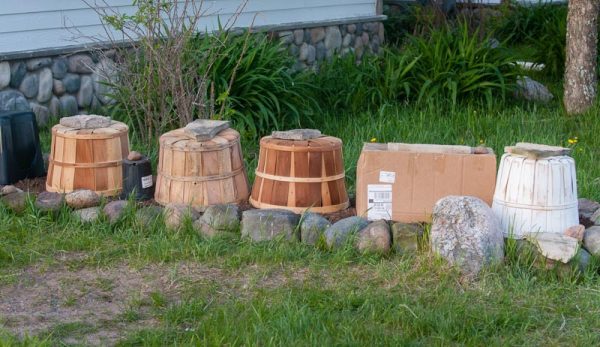
Picture the scene: It’s spring and your garden beds are filled with tiny seedlings pushing toward the sunlight. Maybe you’ve planted some larger tomato plants from a nursery. Perhaps the pumpkin plants are starting to grow their first true leaves.
Yes, your garden is growing beautifully. But now the weather forecast calls for frost danger with a nighttime low temperature of 30 degrees F.
Yikes! Is your lovely young garden in danger of being leveled by frost in a single evening? Not necessarily. Before you admit defeat, give cloches a try.
What’s a Cloche?
Every gardener needs a collection of garden cloches at their disposal. In its truest form, a cloche is a piece of glass or transparent plastic shaped rather like a bell. In fact, “cloche” is the French word for bell.
A cloche is placed over cold-sensitive plants to trap heat and protect them from frost and chilly temperatures. On cold nights, a cloche can determine whether a plant lives or dies.
Garden cloches come in many forms. Some are bells, others resemble miniature greenhouses … and some are random items gathered together in a hurry when the forecast turns chilly and you have dozens or hundreds of plants to protect.
In the latter instances, garden cloches need not be attractive or designed for long-term use. Any object capable of trapping heat (particularly heat radiating up from the ground) can serve as a suitable cloche when cold temperatures loom. You’ll want to remove them come morning (after temperatures warm back up), but the time spent covering and uncovering is worthwhile if it saves your garden.
Here are a few items to use as garden cloches in a pinch.
1. Cardboard Boxes
Cardboard boxes are everywhere, and they come in many sizes, making it simple to adapt them to your specific garden layout. Some cardboard boxes are big enough to cover multiple plants at once, reducing the number of cloches you need.
But you may have to cut the flaps off to fit multiple boxes side by side.
Keep in mind two potential pitfalls. First, cardboard boxes are lightweight, so you may have to set rocks or other heavy items on top so they don’t blow away. Second, cardboard boxes can deteriorate if they get wet. It would be unfortunate if a cardboard box crumpled under the weight of rocks and wound up crushing the plants it aimed to protect.
Read more: Check out more tips for protecting your garden against frost and freeze.
2. Paper or Plastic Cups
Paper and plastic cups look a lot like tiny cloches. Indeed, they can be used in the same way. Cups make fine covers for small seedlings, though if you have many seedlings planted in rows, it might be more practical to opt for a few large covers (like big cardboard boxes) than use dozens of cups.
3. Baskets & Buckets
Provided their handles don’t get in the way, baskets and buckets make effective cloches. They’re not as inexpensive or widespread as cardboard boxes, but they’re sturdier.
If you have a large collection of apple-picking baskets sitting around waiting for fall, call them into service as cloches.
Read more: Make a cold frame with a 5-gallon bucket!
4. Planting Pots
Similar to baskets and buckets, planting pots (ceramic, plastic, etc.) are sturdier than cardboard boxes, and chances are you have a few of them around. Just keep in mind that the holes in the bottom will let heat escape when the pots are flipped upside down. You’ll want to find a way to cover the holes.
These are just a few of the many possible items you can put to use as emergency garden cloches. What items have you tried?




